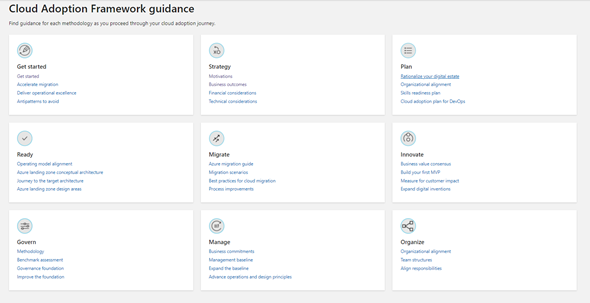The first question to ask is whether moving to the cloud is the right thing for you to do. After all, each organization is unique. What are your business objectives? What´s the required investment versus the return? Does a cloud-based business model fit in with your organization or do you need to change the model or the organization? What´s the technology and expertise that´s required? Is it something you can do yourself, or do you need expert assistance?
This blog will help you in getting some of these questions answered. Our Xpirit team has supported dozens of organizations, ranging in size from global corporations to SMEs, in making a successful transition to the cloud using the proven Microsoft platform. A valuable part of this platform is the Microsoft Cloud Adoption framework, which assists you in investigating your motivation and clarifying your strategy. The following image shows the key areas of your investigation.

Getting started and strategy
The Microsoft Cloud Adoption framework helps you focus on your business objectives. Why would you move your business to the cloud? Is it because of cost savings, or do you want to enable a new business model for your products and services? For instance, do you want to upscale to be able to match market demand?
If moving to the cloud is the right decision to achieve your business objectives, the next step consists of investigating the steps you need to undertake. This means taking stock of your digital estate, including a list of all your technical servers. You need to decide whether you need to move them, rearchitect them, rehost, rebuild, refactor, or maybe just to retire them, i.e. the five Rs of rationalization.
From the organizational perspective, you need to ensure that your skill set matches what you want to achieve or that you can grow to match the required skillset. Most likely the organization of your business also needs to change in order to truly embrace the cloud and the move to the cloud. These changes require a broad commitment to ensure your success. Moreover, to truly embrace the cloud, companies need to adopt a DevOps way of working, which leads to rethinking your organization. At Xpirit we help companies to get started in migrating to and working with the cloud. At the same time, we guide them to implement the DevOps approach, from a technical perspective as well as from an organizational perspective.
Creating the right foundation
When you are ready to move to the cloud, a key success factor is a solid and secure foundation for your applications. As a company, you will still need to think about cross-cutting concerns such as security, networking, compliance, costs, etc. However, your teams may be responsible for this and they should be enabled to do so effectively and efficiently. Here the concept of a landing zone comes in, which is the concrete implementation of the foundation that will help your teams to be effective (What is an Azure landing zone? Cloud Adoption Framework | Microsoft Docs).
These landing zones can be easily customized to create a seamless fit with your organization’s requirements and thus be the enabler for your migration. At Xpirit we offer out-of-the-box landing zones that derive their value from our seven years of experience in building them. We have identified multiple flavors of these landing zones, based on the domain that customers work in. In addition, we have automated and optimized them, allowing them to be deployed and up and running within a period of two weeks. Some examples:
Our Data&AI landing zone is a great start for companies that rely heavily on Data&AI workloads. We created this landing zone together with our sister company Go Data Driven (Xebia / Driving your success with AI).
The Public Sector landing zone focuses heavily on compliance and concerns that are relevant for local or national government bodies.
Our Business Apps/Independent Software Vendor (ISV) landing zone helps ISVs in creating the scale that is required to meet market demand. This landing zone allows them to make a fast and reliable transition to a worldwide scale. Typically these companies have one or more apps that need to be enabled worldwide or that need to harness the scalability and reliability principles of the Azure Cloud.
Of course, we can also review your landing zone or create a custom zone that suits your organization.
Get started with Landing Zones
Are you preparing for your cloud migration? Get started with our workshop Landing Zone in a Day. After taking the workshop, your team fully understands the concept of a landing zone, and they will be able to build, implement and maintain their own landing zone.
More information
Feel free to contact us at any time, chat with us via the on our website, read our blogs on landing zones by and , or browse through the following documents and video to help you make the right decisions.





